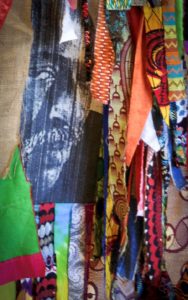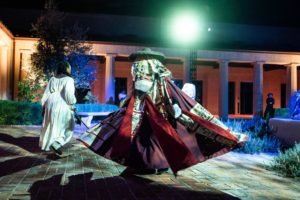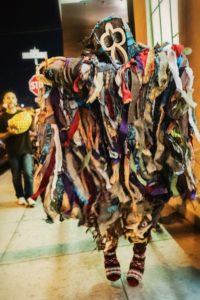
[Image description: Close-up of the Egungun costume created in veneration of Ed Mock and those ancestors of the Valencia Street Corridor. Composed of multiple layers of cloth lappets, these fabrics represent the strength of the multicultural collective coexistence through the power of our continued artistic influences.]
I didn’t wake up one day thinking I should create ritual costumes. They snuck up on me. They whispered to me, they brought magic into my home and drew me into their clutches. Those whispers came from a human most people know as Amara Tabor-Smith. In this article I share an inside peek into the approach I use to conceptualize and render ritual costumes in general and take a look at how that works in practice in my collaborations with House/Full of BlackWomen Co-Creators Amara Tabor-Smith and Ellen Sebastian Chang.
The starting point for a successful ritual costume process lies in drawing out a clarity of the intention behind the planned ritual performance and then breathing that intention into each step of the design and construction process. Ritual performance combines art and aesthetics as an instrument to inform viewers about beliefs, the constructs of our ancestral origins. It calls upon education and contemplation to understand diasporic experiences while honoring and retaining our cultures and grounding in our identities. It brings about perspectives that we might otherwise overlook, deny or refuse to see. It often infuses….It is a digestion that can transform us.
You see, what I have learned about ritual costume design and creation is that it is in essence a guided process with spirit at its core. It is not based on perfect construction of the garment but rather a mindset born of an earnest desire to understand, honor and respect the traditions where they are derived. It is an openness to embark on a journey where you as the creator let go of ego to solely embrace the intent of those who will wear it, heightening awareness of the messages and materials that appear during the process of creating and then trusting that those materials showed up so you can integrate them in a meaningful way. It is as if spirit is guiding you through the process, telling you what to do—as long as you listen.
Costumes and fabric share a long history. French poet Charles Baudelaire’s phrasing of the essence of that relationship speaks for me: “fabrics speak a silent language.” RISD Museum expands that, speaking to the Egungung costumes I create:
Its universal significance and applicability might sometimes be culturally specific, but in essence spans the entire gamut of our collective human experience. Though it has no voice, cloth speaks in complex, multisensorial fashions.[1]
The ritual costume serves as a dramatically symbolic vessel carrying a story all its own while holding space for embodiment of spirit. It is an instrument called to action that is imbued in the fabric of intention whereby we can carry out those intentions with respect to the world, our fellows, ourselves and our traditional beliefs. They hold a backbone of courage that dares to hold truth through subliminal messages, alluring layers with complex meaning carried on the backs of channelers. They are a canvas for the integration of symbolic references, for spirit and woven in the fabric of life’s journeys. They recall ancestral guides deepening our awareness and bringing forth new perspectives in moving forward. They are a protective womb of safety to release the injuries of the past and move forward toward healing.
The Concept

[Image description: The Media Egungun adorned with panels of historical newsprint about the Black Power Movement in the 1970s. It tells the story and embodies the spirit. A reminder to stand. Production: REVIVAL: Millennial reMembering in the Afro NOW]
My process of conceptualization draws inspiration from various points during development. There are typically portions of Amara’s and Ellen’s projects where they are clear in their vision while other parts that remain open, providing room for improvisation. As they tell the story underlying the performance give rise to strong visions of the setting within me. Their explanations evoke a series of symbols, metaphorical relationships, spiritual overtones/undertones, objects, textiles, organic matter, texture that seem to appear within my mind. Having worked with Amara and Ellen for nearly eight years now, I have gained an understanding of the general aesthetic that appeals to them and communicates the feeling with which they hope to fill their audience. Once I understand the environment, I inquire about the main characters, their roles and their deity overlays. The pivotal points in the performance determine where visuals need to make a specific impact and where the costumes integrated with the set design are of major importance.
The performers selected for those characters inform the final phase of the costume design process. Amara’s identification of the role, the deity overlay, coupled with the chosen performer can bring clarity defining the essence of the costume. In my design process, I draw from African traditions, Yoruba traditions, historical era, specific objects related to a specific era, possessing symbolic significance with an earthly element to it.
What is an Egungun?

[Image description: Venerating the spirit of Ana Mendieta, this Egungun grounded in the definition of “HOME.” The carved wood silueta mask, imbued fabric with earthborn colors, oxblood, birds, insects, dirt and ash came alive, took residence and blessed us with indelible appreciation of presence through longing and the immortality of life when it ends. Production: EarthBodyHOME]
The Egungun plays a prominent recurring role in Amara’s and Ellen’s House/Full series. Some readers may appreciate knowing a bit of background on Egungun and their history. The RISD Museum offers one of my favorite descriptions:
Made into elaborate decorative patterns, forms, and colors, these carefully arranged fabrics must follow the well-established conventions of the past, best defined here as those representing the treasured values of Egungun traditions, or asa. Asa represents a conscious attempt “to select, choose, discriminate, or discern” (Yai, 1994) while being cognizant of the historical past. Quite logically, artists-priests-devotees use their oju ona (design consciousness) together with oju inu (inner eye or artistic insight and sensibility) as well as laakaye (intuitive knowledge) plus imoju-mora (unusual sensitivity) in order to make deliberate choices (Abiodun, 1989; Lawal, 1996) in the selection of colors, patterns, and designs. This dynamic artistic process is constantly inventive, revitalizing, and modern. The result is that the cloth panels come in a multiplicity of designs, patterns, hues, shapes, and colors—a curious blend of disparate elements fully reflective of the multidimensional vision and power of departed ancestors.[2]
The Costume
The moment I live for is when the performer puts on the finished costume for the first time. Embodying the character in the costume brings the costume alive and the costume transforms the spirit of the performer, which together become the vessel to deliver the intention to the audience that the directors articulated weeks or months before.
In the House/Full of Black Women episode “Passing Through The Great Midde,” the directors said they wanted a “bone dress.” Curiously, I wasn’t shocked. They told me the story of a young woman aboard a slave trader ship who was ordered—and who refused—to dance for the crew. So they bound her to a halyard, hoisted her up the mast and dropped her to the deck, again and again long after she perished. When Amara and Ellen retold this story at each rehearsal, I could feel my own body being hoisted, followed by the free falling weightless emptiness only to crash in blinding pain. This sensation imprinted itself in my soul. This bone dress was to honor this young woman’s spirit, to tell her story, to set her free. This costume needed to scream in anger, it needed to cry in pain, it needed strength held deep in principle, it needed an ocean’s sway, it needed air for spirit to flow through it, it needed to hold the echo of ghosts, it needed the allure of beauty followed by a recoiling to the ugly, ugly truth.

[Image description: This Egungun adorned in antiqued mirrors and lace carries a reflective domed face mask only allowing you to see a reflection of yourself. It beckons you to ask yourself “What kind of ancestor do you want to be?” Production: REVIVAL: Millennial reMembering in the Afro NOW]
Garment construction begins with a visualization process. I mentally visualize the entire set design look and feel while thinking about how costumes might punctuate the space. I ask how the performers will move through the space, how much movement will they be doing, will they be solo or part of a larger group in movement?
From there I can see the silhouette of the costume followed by a general understanding of the overall construction. Typically starting from the base garment or garment that is closest to the body, I define what will work best in terms of form and function. What would be most comfortable, identifying fabrics, style that support their movement. From the undergarment I think in layers, what needs to be composed over that undergarment to achieve the silhouette.

[Image description: Layers of fishing net, volleyball net, lace and animal bones over an asymmetrical composition of binded hoop wires and backpack straps lends itself to a broken silhouette. Her silhouette, crashing to the floor of the slave ship. The bones speak. Production: Passing Through the Great Middle]
Once the scenes are laid out, other specifics emerge driving costume design, such as the number of performers per scene, who is cast in those roles, what the set will look like, the amount and type of movement, what function they will support in the story line. Now specific deity references enter the process which informs the essence of costume character such as Mother of the Ocean, the universal element they embody such as water, fire, earth, wind, the objects that are symbolic for the deity and colors.

[Image description: Layers of fishing net, volleyball net, lace and animal bones over an asymmetrical composition of binded hoop wires and backpack straps lends itself to a broken silhouette. Her silhouette, crashing to the floor of the slave ship. The bones speak. Production: Passing Through the Great Middle]
I strive to bring a consistent look for the overall production entailing purchasing similar items with variations of style and then there are special ritual costumes for key roles. As advocates for material reuse, we place intention on items that are purchased for future reconstruction or creative alternative use.
When designing the special ritual costumes, during the construction process I consider versatility in form, function, sizing and simplicity in reconstruction. Versatility plays a key factor as cast members can change requiring quick costume adjustments. Honoring the spiritual nature of the performance, these special costumes are built with clear intention as a vessel that will hold the intended grace of the message.
The underlayer garment typically includes a form of protection for the performer who will wear the costume. That protection can be in the form of a talisman/amulet/herb/symbolic characters etc. The structural inner layer I view as the bones (usually figuratively, though not always!), which provides a strong structure to build on.
The outer layer includes the fabric base of which specific embellishment and symbolic object oriented adornment can be supported. Through the combined integration of each layer that imbues the costume in preparation for the ritual performance. This includes the collaborative collection of meaningful fabrics and objects, ritualistic processes often used to create the objects, spiritual practices in placing the objects—all with clear intention throughout.
Inside the Experience

[Image description: The Egungun created for Ed Mock. Production: He Moved Swiftly But Gently Down the Not Too Crowded Street: Ed Mock and Other True Tales in a City That Once Was]
The feeling I get when entering a rehearsal space can only be described as like entering a remote island, a village, with people who share a deep love, compassion and acceptance for each other focused on the positive aspects of the gifts that each person brings. The space holds a respect that is beyond words where each individual feels safe to be their authentic selves and are able to express in a way that is grounded at a level that allows them to share who they are in whatever way that they truly are. There is a grace, a gentleness and understanding that is held by all to support each other in a way that I’ve not experienced in the outside world. It feels to me that it is a world that existed in the past, a world as all worlds should be based in a love for each other that we as human beings have lost along the way, making it feel unsafe to be our authentic selves.
My experience with House/Full has been grounding. It has given me a perspective rooted in extremes: one like a raw open wound to another of unlimited power to express. It has afforded me the opportunity to understand deep pain and pure joy—sometimes together. Doing so widens my awareness not only about others but also within myself. It can be uncomfortable at times but looking back over the years my depth of understanding my place in this world, what I bring, where I fall short and how I can use what I have as best as possible to help others continues to become more and more clear. That clarity about who you are and what you bring helps to inform all choices you make with clear intention.
I never thought that making costumes would open a door into such a rich life journey. But I often think that I have the best job in the world as I am able to intimately collaborate with highly talented artists that process life in a deeply profound way, dig into the roots of understanding ancestral history and traditions, gain a perspective on history and how it informs us today, integrate all of those aspects and create tangible references that can support visual impacts to provoke questions, raise awareness, promote healing and celebrate our existence. What can be better than this?
Until the next time…
It’s been great to have a chance to write about and bring words to my work—a space that ordinarily has precious few of those. I would like to take this opportunity to express thanks to the Bay Area ritual dance community, the directors and dancers, for inviting me into your sacred midst. I consider myself privileged to be a member. Looking forward to seeing you all in a theater as soon as we are able!
[1] By Bolaji Campbell, Cloth as Metaphor in Egungun Costumes, RISD Museum, July 10, 2016, <https://risdmuseum.org/manual/445_cloth_as_metaphor_in_egungun_costumes>.
[2] By Bolaji Campbell, Cloth as Metaphor in Egungun Costumes, RISD Museum, July 10, 2016, <https://risdmuseum.org/manual/445_cloth_as_metaphor_in_egungun_costumes>.
This article appeared in the Fall 2020 issue of In Dance.

